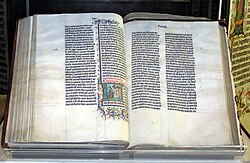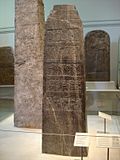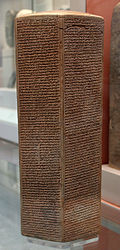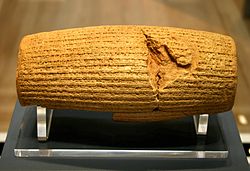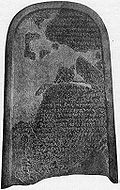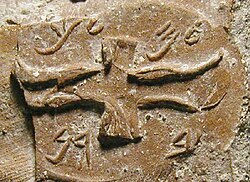| Inscription | COS | ANET |
|---|
| Ref. | Title | Ref. | Title |
|---|
| Pyramid Texts | 1.4 | Pyramid Texts Spell 600 | 3 | The Creation by Atum |
| 1.9 | Papyrus Bremer-Rind | 6–7 | The Repulsing of the Dragon and the Creation |
| Shabaka Stone | 1.15 | The "Memphite Theology" | 4–6 | The Theology of Memphis |
| 1.17 | Coffin Texts Spell 1130 | 7–8 | All Men Created Equal in Opportunity |
| Book of the Dead | 1.18 | Book of the Dead 175 | 9–10 | The Primeval Establishment of Order |
| Coffin Texts | 1.19 | Coffin Text 157 | 10 | The Mythological Origin of Certain Unclean Animals |
| 1.21 | The Repulsing of the Dragon | 11–12 | The Repulsing of the Dragon |
| 1.22 | The Legend of Isis and the Name of Re | 12–14 | The God and His Unknown Name of Power |
| Astarte and the Insatiable Sea | 1.23 | The Legend of Astarte and the Tribute of the Sea | 17–18 | Astarte and the Tribute of the Sea |
| Book of the Heavenly Cow | 1.24 | The Destruction of Mankind | 10 | Deliverance of Mankind from Destruction |
| Great Hymn to the Aten | 1.25 | The Great Cairo Hymn of Praise to Amun-Re | 365–367 | A Hymn to Amon-Re |
| 1.27 | Two Hymns to the Sun-god | 367–368 | A Universalist Hymn to the Sun |
| 1.28 | The Great Hymn to the Aten | 369–371 | The Hymn to the Aton |
| Harper's Songs | 1.30 | The Song from the Tomb of King Intef | 467 | A Song of the Harper |
| 1.31 | The Song from the Tomb of Neferhotep | 33–34 | The Good Fortune of the Dead |
| Execration texts | 1.32 | Execration Texts | 328–329 | The Execration of Asiatic Princes |
| 1.33 | Dream Oracles | 495 | The Interpretation of Dreams |
| 1.34 | Daily Ritual of the Temple of Amun-Re at Karnak | 325–326 | The Daily Ritual in the Temple |
| Teaching for King Merykara | 1.35 | Merikare | 414–418 | The Instruction for King Meri-ka-re |
| Instructions of Amenemhat | 1.36 | Amenemhet | 418–419 | The Instruction of King Amen-em-het |
| Story of Sinuhe | 1.38 | Sinuhe | 18–22 | The Story of Si-nuhe |
| Tale of Two Brothers | 1.40 | The Two Brothers | 23–25 | The Story of Two Brothers |
| Story of Wenamun | 1.41 | The Report of Wenamun | 25–29 | The Journey of Wen-Amon to Phoenicia |
| Ipuwer Papyrus | 1.42 | The Admonitions of an Egyptian Sage: the Admonitions of Ipuwer | 441–444 | The Admonitions of Ipu-wer |
| The Eloquent Peasant | 1.43 | The Eloquent Peasant | 407–410 | The Protests of the Eloquent Peasant |
| Instruction of Any | 1.46 | Instruction of Any | 420–421 | The Instruction of Ani |
| Instruction of Amenemope | 1.47 | Instruction of Amenemope | 421–424 | The Instruction of Amen-em-Opet |
| The Satire of the Trades | 1.48 | Dua-khety or the Satire on the Trades | 432–434 | The Satire on the Trades |
| Famine Stela | 1.53 | The Famine Stela | 31–32 | The Tradition of Seven Lean Years in Egypt |
| Bentresh stela | 1.54 | The Legend of the Possessed Princess ("Butresh Stela") | 29–31 | The Legend of the Possessed Princess |
| Myth of Elkunirša | 1.55 | Elkunirsa and Asertu | 519 | El, Ashertu and the Storm-god |
| Illuyanka | 1.56 | The Storm-god and the Serpent (Iluyanka) | 125–126 | The Myth of Iluyankas |
| Telipinu | 1.57 | The Wrath of Telipinu | 126–128 | The Telepinus Myth |
| Muršili II | 1.60 | Plague Prayers of Mursili II | 394–396 | Plague Prayers of Mursilis |
| 1.63 | Uhhamuwa's Ritual Against Plague | 347 | Ritual Against Pestilence |
| Hittite military oath | 1.66 | The First Soldiers' Oath | 353–354 | The Soldiers' Oath |
| Šuppiluliuma I | 1.74 | Deeds of Suppiluliuma | 319 | Suppiluliumas and the Egyptian Queen |
| 1.83 | Instructions to Priests and Temple Officials | 207–210 | Instructions for Temple Officials |
| 1.84 | Instructions to Commanders of Border Garrisons | 210–211 | From the Instructions for the Commander of the Border Guards |
| Baal Cycle | 1.86 | The Ba`lu Myth | 129–142 | Poems about Baal and Anath |
| Legend of Keret | 1.102 | The Kirta Epic | 142–149 | The Legend of King Keret |
| Tale of Aqhat | 1.103 | The 'Aqhatu Legend | 149–155 | The Tale of Aqhat |
| 1.108 | The Descent of Ishtar to the Underworld | 106–109 | Descent of Ishtar to the Nether World |
| 1.109 | Nergal and Ereshkigal | 507–512 | Nergal and Ereshkigal |
| 1.110 | Nergal and Ereshkigal (Amarna Version) | 103–104 | Nergal and Ereshkigal |
| Enūma Eliš | 1.111 | Epic of Creation | 60–72, 501–503 | The Creation Epic |
| Dynasty of Dunnum | 1.112 | The Theogony of Dunnu | 517–518 | A Babylonian Theogony |
| 1.115 | Prayer to Gods of the Night | 390–391 | Prayer to the Gods of the Night |
| Great Prayer to Šamaš | 1.117 | The Shamash Hymn | 387–389 | Hymn to the Sun-god |
| 1.129 | The Adapa Story | 101–103 | Adapa |
| Atra-Hasis | 1.130 | Atra-Hasis | 104–106, 512–514 | Atrahasis |
| 1.131 | Etana | 114–118, 517 | Etana |
| Epic of Gilgamesh | 1.132 | Gilgamesh | 72–99, 503–507 | The Epic of Gilgamesh |
| 1.133 | The Birth Legend of Sargon of Akkad | 119 | The Legend of Sargon |
| 1.134 | Babylonian King Lists | 271, 272, 566–567 | The Babylonian King List B, The Babylonian King List A, A Seleucid King List |
| 1.135 | Assyrian King Lists | 564–566 | The Assyrian King List |
| Babylonian Chronicles | 1.137 | Babylonian Chronicle | 301–307 | The Neo-Babylonian Empire and its Successors |
| 1.143 | An Assurbanipal Hymn for Shamash | 386–387 | Prayer of Ashurbanipal to the Sun-God |
| Adad-guppi | 1.147 | The Adad-Guppi Autobiography | 560–562 | The Mother of Nabonidus |
| Ludlul bēl nēmeqi | 1.153 | The Poem of the Righteous Sufferer | 596–600; 434 | Ludlul Bēl Nēmeqi |
| Babylonian Theodicy | 1.154 | The Babylonian Theodicy | 601–604 | The Babylonian Theodicy |
| Dialogue of Pessimism | 1.155 | Dialogue of Pessimism or the Obliging Slave | 600–601 | The Dialogue of Pessimism |
| 1.171 | Gilgamesh and Akka | 45–47 | Gilgamesh and Agga |
| Dialogue between a Man and His God | 1.179 | "Man and his God" | 589–591 | Man and His God |
| Autobiography of Ahmose Pen-Nekhebet | 2.1 | The Tomb Biography of Ahmose of Nekheb | 233–234 | The Expulsion of the Hyksos |
| 2.2A | The Annals of Thutmose III | 234B–238 | The Annals in Karnak |
| 2.2B | The Gebel Barkal Stela of Thutmose III | 238C, 240D-C | The Barkal Stela |
| 2.2C | The Armant Stela of Thutmose III | 234 A | The Armant Stela |
| 2.3 | The Memphis and Karnak Stelae of Amenhotep II | 245–247 | The Memphis and Karnak Stelae |
| Karnak | 2.4A | [Sethos I] Karnak, Campaign from Sile to Pa-Canaan, Year 1 | 254C, 254A, 254D | Campaigns of Seti I in Asia |
| 2.4C | [Sethos I] Karnak, Campaign to Yenoam and Lebanon (Year 1 or Later) | 254C | Campaigns of Seti I in Asia |
| Beisan steles | 2.4B | [Sethos I] First Beth-Shan Stela, Year 1 | 253–254 | A Campaign of Seti I in Northern Palestine |
| 2.4D | [Sethos I] Second Beth-Shan Stela, Year Lost | 255 | Beth-Shan Stelae of Seti I and Ramses II |
| Kadesh inscriptions | 2.5A | [Ramesses II] The Battle of Qadesh — The Poem, or Literary Record | 255–256 | The Asiatic Campaigning of Ramses II |
| Merneptah Stele | 2.6 | The (Israel) Stela of Merneptah | 376–378 | Hymn of Victory of Mer-ne-ptah (The "Israel Stela”) |
| 2.10 | Coffin Text 159 | 33 | The Fields of Paradise |
| 2.12 | Book of the Dead 125 | 34–36 | The Protestation of Guiltlessness |
| Mesha Stele | 2.23 | The Inscription of King Mesha | 320–321 | The Moabite Stone |
| Siloam inscription | 2.28 | The Siloam Tunnel Inscription | 321 | The Siloam Inscription |
| Yehimilk inscription | 2.29 | The Inscription of King Yahimilk | 653–654 | Yehimilk of Byblos |
| Kilamuwa Stela | 2.30 | The Kulamuwa Inscription | 654–655 | Kilamuwa of Y'dy-Sam'al |
| Yehawmilk Stele | 2.32 | The Inscription of King Yehawmilk | 656 | Yehawmilk of Byblos |
| Stele of Zakkur | 2.35 | The Inscription of Zakkur, King of Hamath | 655–656 | Zakir of Hamat and Lu`ath |
| Ahiram sarcophagus | 2.55 | The Sarcophagus Inscription of ‘Ahirom, King of Byblos | 661 | Ahiram of Byblos |
| Tabnit sarcophagus | 2.56 | The Sarcophagus Inscription of Tabnit, King of Sidon | 662 | Tabnit of Sidon |
| Sarcophagus of Eshmunazar II | 2.57 | The Sarcophagus Inscription of 'Eshmun`azor, King of Sidon | 662 | Eshmun`azar of Sidon |
| Sefire steles | 2.82 | The Inscription of Bar Ga'yah and Mati`el from Sefire | 659–661 | The Treaty between KTK and Arpad |
| Gezer calendar | 2.85 | The Gezer Calendar | 320 | The Gezer Calendar |
| Arslan Tash amulets | 2.86 | An Amulet from Arslan Tash | 658 | The Amulet from Arslan Tash |
| Kurkh Monoliths | 2.113A | [Shalmaneser III] Kurkh Monolith | 277–278 | [Shalmaneser III] Annalistic Reports (i 29 – ii 13) |
| 2.113B | [Shalmaneser III] Annals: Assur Clay Tablets | Cf. 278–279 | [Shalmaneser III] Annalistic Reports |
| 2.113C | [Shalmaneser III] Annals" Calah Bulls | 279–280 | [Shalmaneser III] Annalistic Reports (Bull Inscription) |
| Black Obelisk of Shalmaneser III | 2.113F | [Shalmaneser III] Black Obelisk | 278–281 | [Shalmaneser III] Annalistic Reports (Black Obelisk) |
| 2.113G | [Shalmaneser III] Assur Basalt Statue | 280 | [Shalmaneser III] Various Inscriptions (a) |
| 2.113H | [Shalmaneser III] Black Stone Cylinder | 281 | [Shalmaneser III] Various Inscriptions (c) |
| Saba'a Stele | 2.114E | [Adad-nirari III] Saba'a Stela | 282 | [Adad-Nirari III] (b) Saba'a Stela |
| 2.117A | [Tiglath-Pileser III] The Calah Annals | 282–283 | [Tiglath-Pileser III] Annalistic Records (103-133) |
| 2.117C | [Tiglath-Pileser III] Summary Inscription 4 | 283–284 | [Tiglath-Pileser III] Annalistic Records (1-34) |
| Annals of Sargon II | 2.118A | [Sargon II] The Annals | 285 | [Sargon II] From Annalistic Reports (23-57) |
| Sargon Stele | 2.118E | [Sargon II] The Great “Summary" Inscription | 284–285 | [Sargon II] Inscriptions of a General Nature (1) |
| Annals of Sargon II | 2.118F | [Sargon II] The Small “Summary" Inscription | 285 | [Sargon II] From Annalistic Reports (11-15) |
| Sargon II's Prisms | 2.118i | [Sargon II] The Nimrud Inscription | 287 | [Sargon II] From Broken Prisms (3) |
| Sennacherib's Annals | 2.119B | Sennacherib's Siege of Jerusalem | 287–288 | [Sennacherib] (a) The Siege of Jerusalem |
| Cyrus Cylinder | 2.124 | Cyrus Cylinder | 315–316 | Cyrus |
| Laws of Eshnunna | 2.130 | The Laws of Eshnunna | 161–163 | The Laws of Eshnunna |
| Code of Hammurabi | 2.131 | The Laws of Hammurabi | 163–180 | The Code of Hammurabi |
| 2.132 | The Middle Assyrian Laws | 180–188 | The Middle Assyrian Laws |
| 2.133 | The Neo-Babylonian Laws | 197–198 | The Neo-Babylonian Laws |
| Code of Ur-Nammu | 2.153 | The Laws of Ur-Nammu | 523–525 | The Laws of Ur-Nammu |
| Lipit-Ishtar | 2.154 | The Laws of Lipit-Ishtar | 159–161 | Lipit-Ishtar Lawcode |
| Gudea cylinders | 2.155 | The Cylinders of Gudea | 268–269 | Gudea, ENSI of Lagash |
| 3.2 | The Craft of the Scribe | 475–479 | A Satirical Letter |
| Papyrus Anastasi I | 3.3 | Praise of Pi-Ramessu (Papyrus Anastasi I) | 471 | In Praise of the City Ramses |
| 3.4 | A Report of Escaped Laborers (Papyrus Anastasi V) | 259 | The Pursuit of Runaway Slaves |
| 3.5 | A Report of Bedouin (Papyrus Anastasi VI) | 259 | The Report of a Frontier Official |
| Judicial Papyrus of Turin | 3.8 | The Turin Judicial Papyrus (The Harem Conspiracy against Ramesses III) | 214–216 | Results of a Trial for Conspiracy |
| 3.10 | A Lawsuit over a Syrian Slave | 216–217 | From the Record of a Lawsuit |
| Yavne-Yam ostracon | 3.41 | The Mesad Hashavyahu (Yavneh Yam) Ostracon | 568 | A Letter from the Time of Josiah |
| Lachish letters | 3.42A | Lachish Ostraca [2] | 322 | Lachish Ostracon II |
| 3.42B | Lachish Ostraca [3] | 322 | Lachish Ostracon III |
| 3.42C | Lachish Ostraca [4] | 322 | Lachish Ostracon IV |
| 3.42D | Lachish Ostraca [5] | 322 | Lachish Ostracon V |
| 3.42E | Lachish Ostraca [6] | 322 | Lachish Ostracon VI |
| 3.42F | Lachish Ostraca [9] | 322 | Lachish Ostracon IX |
| Arad ostraca | 3.43A | Arad Ostraca [1] | 569B | Three Ostraca from Arad (A) |
| 3.43H | Arad Ostraca [17] | 569C | Three Ostraca from Arad (B) |
| 3.43i | Arad Ostraca [18] | 569A | Three Ostraca from Arad (C) |
| Elephantine papyri and ostraca | 3.46 | [The Jedaniah Archive from Elephantine] The Passover Letter | 491 | "The Passover Papyrus" |
| 3.51 | [The Jedaniah Archive from Elephantine] Request for Letter of Recommendation (First Draft) | 491–492 | Petition for Authorization to Rebuild the Temple of Yaho |
| 3.52 | [The Jedaniah Archive from Elephantine] Recommendation for Reconstruction of Temple | 492 | Advice of the Governors of Juda and Samaria to the Jews of Elephantine |
| 3.53 | [The Jedaniah Archive from Elephantine] Offer of Payment for Reconstruction of Temple (Draft) | 492 | Petition by Elephantine Jews, Perhaps to Arsames |
| 3.65 | [The Mibtahiah Archive] Withdrawal from Goods | 491 | Settlement of Claim by Oath |
| 3.87C | Offer to Sew a Garment | 491 | Letter from One Jew to Another of Superior Station |
| 3.87E | Greetings from a Pagan to a Jew | 491 | Greeting from a Pagan to a Jew |
| Amarna letters | 3.92A | Letter of Abdi-heba of Jerusalem (EA 286) | 487–488 | [The Amarna Letters] EA, No. 286 |
| 3.92B | Letter of Abdi-heba of Jerusalem (EA 289) | 489 | [The Amarna Letters] EA, No. 289 |
| 3.92C | Letter of the Ruler of Gazru (EA 292) | 489–490 | [The Amarna Letters] EA, No. 292 |
| 3.92G | Letter of Lab'ayu of Shechem (EA 254) | 486 | [The Amarna Letters] EA, No. 254 |
| 3.129 | Inheritance of a Brother and Sister | 545–546 (§ 14) | Litigation Concerning Inheritance |
| Dispute between a man and his Ba | 3.146 | The Dispute Between a Man and His Ba | 405–407 | A Dispute Over Suicide |
| Anzû | 3.147 | The Akkadian Anzu Story | 514–517 | The Myth of Zu |
